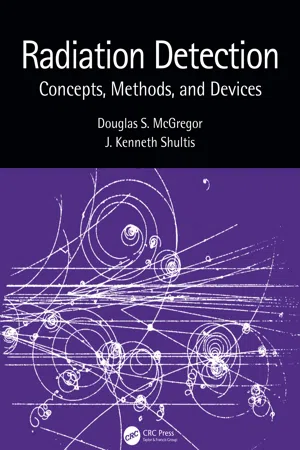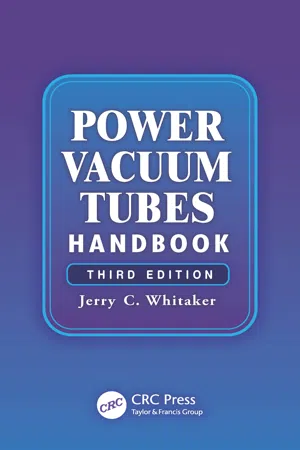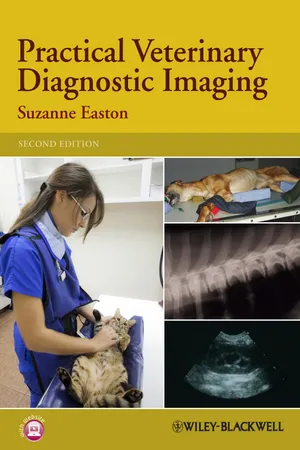Physics
Cathode Rays
Cathode rays are streams of electrons that are emitted from the negative electrode, or cathode, in a vacuum tube. They were first observed by British physicist J.J. Thomson in the late 19th century and played a crucial role in the discovery of the electron. Cathode rays are important in understanding the behavior of charged particles and have applications in various electronic devices.
Written by Perlego with AI-assistance
5 Key excerpts on "Cathode Rays"
Learn about this page
Index pages curate the most relevant extracts from our library of academic textbooks. They’ve been created using an in-house natural language model (NLM), each adding context and meaning to key research topics.
- eBook - ePub
Radiation Detection
Concepts, Methods, and Devices
- Douglas McGregor, J. Kenneth Shultis(Authors)
- 2020(Publication Date)
- CRC Press(Publisher)
Fig. 1.7 . With these tubes Thomson made three fundamental experimental observations. First, he noted that magnetic fields and electric fields could deflect the trajectory of the Cathode Rays.Figure 1.6. Joseph John Thomson (1856–1940).Figure 1.7. The cathode ray tube apparatus used by Thomson to measure the q/m ratio for Cathode Rays.Further, given a known magnetic field strength, he noted that the deflection of these Cathode Rays was far greater than observed for positively charged hydrogen gas. Finally, by comparing the results of the Cathode Rays and the hydrogen gas, Thomson noted that the charge-to-mass ratio was approximately 1800 times greater for the Cathode Rays than for hydrogen ions.2 Because he was confident no gas was inside the cathode ray tube, in 1897 Thomson correctly deduced that Cathode Rays were in fact negatively charged particles emitted from the cathode surface or, more correctly, emitted from the atoms composing the cathode. Although Thomson named these newly identified negative particles “corpuscles,” the eventual name given to them was electrons as suggested by George Johnston Stoney, who had actually predicted the presence of these negative particles as early as 1874.It should be noted that Thomson’s discovery was the first recorded indication that atoms consisted of subatomic particles, thereby, earning him the 1906 Nobel Prize in Physics. Thomson’s discovery was made possible, in part, with another type of radiation detector, namely the fluorescent screen of the CRT.The observations and findings of Becquerel caught the interests of Pierre and Marie Curie, both chemists by education (see Fig. 1.8 ). Marie began studying under Becquerel, and began a systematic investigation of the known elements to determine if other materials emitted energetic rays similar to those from uranium. While studying pitchblende, an uranium ore containing various oxides, thorium, and other rare earth elements, she found that thorium and thorium compounds also emitted energetic rays. Marie is generallycredited with recommending the name radioactivity3 - eBook - ePub
X-Ray Imaging
Fundamentals, Industrial Techniques and Applications
- Harry E. Martz, Clint M. Logan, Daniel J. Schneberk, Peter J. Shull(Authors)
- 2016(Publication Date)
- CRC Press(Publisher)
2 X-Ray History2.1HISTORY INTRODUCTION
In this chapter, we will introduce the student to the pivotal events and some of the interesting side roads in the history of industrial radiography. We begin with the Crookes tube, then describe Röntgen’s discovery of x-rays in detail, and finally touch upon the other major historical developments that form the foundation for today’s industrial radiography industry.Upon completion of this chapter, you will have been introduced to the following:- Crookes tube
- Cathode ray tube
- Röntgen’s discovery of x-rays
- Röntgen’s publication
- Events after the discovery
- Röntgen’s Nobel Prize
- Injuries and inappropriate use of x-rays
- Coolidge’s improved x-ray tube
- Pioneers in computed tomography (CT): Cormack and Hounsfield (with homage to Radon)
- The beginning of industrial CT
- Important enabling technologies for industrial CT
2.2LAYING THE FOUNDATION
In 1875, Sir William Crookes invented what came to be known as the Crookes tube, the forerunner of cathode ray tubes (CRTs) used for computer and television imagery. The Crookes tube (sometimes referred to as a discharge tube* ) is a partially evacuated device with two or more electrodes that penetrate the glass envelope (see Figure 2.1 ). The negative electrode is called the cathode, and the positive electrode is called the anode. A high voltage is applied across the electrodes, causing ionization of the low-pressure gas inside the tube. This in turn causes positive ions to bombard the cathode, liberating what was called, at that time, Cathode Rays. We now use the term electrons, denoted β− , as synonymous with Cathode Rays.The electrons produced at the cathode are accelerated by the imposed voltage in a direction generally perpendicular away from the surface of the cathode. These electrons traverse the tube. Some interact with the residual gas (gas that has not been evacuated) in the tube, but many strike the anode or the glass wall of the tube. We know now that these interactions produce x-rays. - eBook - ePub
- Jerry Whitaker(Author)
- 2017(Publication Date)
- CRC Press(Publisher)
3 Vacuum Tube Principles3.1 Introduction
A power grid tube is a device using the flow of free electrons in a vacuum to produce useful work [1]. It has an emitting surface (the cathode), one or more grids that control the flow of electrons, and an element that collects the electrons (the anode). Power tubes can be separated into groups according to the number of electrodes (grids) they contain. The physical shape and location of the grids relative to the plate and cathode are the main factors that determine the amplification factor (μ) and other parameters of the device. The physical size and types of material used to construct the individual elements determine the power capability of the tube. A wide variety of tube designs are available to commercial and industrial users. By far the most common are triodes and tetrodes.3.2 Characteristics of Electrons
Electrons are minute, negatively charged particles that are constituents of all matter [1]. They have a mass of 9 × 10−28 g (1/1840 that of a hydrogen atom) and a charge of 1.59 × 10−19 C. Electrons are always identical, irrespective of their source. Atoms are composed of one or more such electrons associated with a much heavier nucleus, which has a positive charge equal to the number of the negatively charged electrons contained in the atom; an atom with a full quota of electrons is electrically neutral. The differences in chemical elements arise from differences in the nucleus and in the number of associated electrons.Free electrons can be produced in a number of ways. Thermonic emission is the method normally employed in vacuum tubes. The principle of thermonic emission states that if a solid body is heated sufficiently, some of the electrons that it contains will escape from the surface into the surrounding space. Electrons also are ejected from solid materials as a result of the impact of rapidly moving electrons or ions. This phenomenon is referred to as secondary electron emission - eBook - ePub
Modern Diagnostic X-Ray Sources
Technology, Manufacturing, Reliability
- Rolf Behling(Author)
- 2021(Publication Date)
- CRC Press(Publisher)
M . The transmitting agent propagated rectilinearly. Its intensity fell with the inverse square of the increasing distance to the source. Initially, Roentgen failed to identify the characteristics of light such as reflection or interference. He concluded an upper limit of the refractive index of aluminum of 1.05. Later, the deviation of the absolute value from unity indeed turned out comparatively small and even negative. Although not sure about the basic physics, he laid the firm ground for early diagnostic and therapeutic applications of X-rays.The working principle until the development of thermionic cathodes in 1913 by Coolidge, when gas eventually became obsolete, was always similar. Upon ionization, the number of electrons moving through a gas cloud in ion tubes increased exponentially along the journey, characterized by the first Townsend coefficient. Electrons escaped toward the target, where they interacted with atomic nuclei to generate X-ray photons. Ions were drawn to the cathode and released more electrons upon impact, a process characterized by the second Townsend coefficient. While processes in the Geissler tubes from the 1850s were described well enough by the first Townsend coefficient, the second became the dominating parameter for X-ray production. A sufficiently low gas pressure was required to allow electrons to gain enough speed before the next collision with a gas molecule and high-energy impact on the target. A characteristic “dark space” had to extend throughout most of the tube. Ions impacting on the cathode cup at the left in Figure 1.1 released up to a dozen electrons, depending on the condition of the surface, like dielectric layers, see the close-up picture in Figure 1.12d , adsorbed gas molecules and other coverage. The electrostatic field generated by the cathode cup accelerated the electrons between the cathode and the target. Concave cathodes focused them into the typically elliptic focal spot on the target, which was glass in the tube type of Figure 1.1 - eBook - ePub
- Suzanne Easton(Author)
- 2012(Publication Date)
- Wiley-Blackwell(Publisher)
Chapter 4 The X-ray TubeChapter contents The tube housing The cathode The anode The line focus principle The anode-heel effect The stator assembly Tube rating How to look after your X-ray tube Further readingKey pointsIntroduction- The cathode is the negative part of the X-ray tube and produces electrons through the heating of the tungsten filament
- Electrons are collected in a focussing cup that controls the electron stream through electrostatic focussing
- The filament size regulates the size of the focal spot. The smaller the focal spot, the smaller the penumbra generated
- The anode is the positive end of the X-ray tube with a tungsten target where fast-moving electrons are rapidly decelerated, resulting in the formation of X-rays
- The target is angled to provide a greater surface area for the electrons to strike and rotates to spread the heat loading over a larger area, preventing overheating
- The cathode and anode are supported in a glass envelope containing a vacuum, allowing maximum efficiency to the acceleration of the electrons
- X-rays are produced as bremsstrahlung and characteristic radiation with 99% of the energy produced in the form of heat
- The glass envelope is surrounded by oil, lead and an aluminium casing
- The electrons are accelerated from the cathode to the anode when a potential difference is applied across the tube. This potential difference ranges from 40 to approximately 90 kV in veterinary radiography
- X-rays exit the tube through an opening in the lead that contains aluminium to remove the very-low-energy X-rays. The X-rays are emitted in all directions, but the tube window only limits the use of X-rays to those moving in a forward direction
- Every X-ray tube has a maximum amount of electrical energy it is able to receive, which is known as the tube loading
The X-ray tube is continuously evolving and becoming more efficient over time. It uses the electrons produced at the cathode to produce X-rays as they interact with the tungsten at the anode. The key components of the rotating anode X-ray tube are (Figure 4.1




